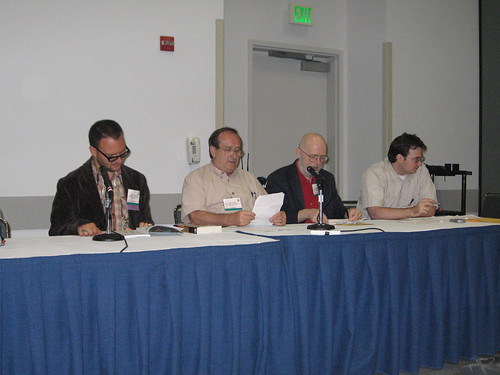In February of 2005, I pointed out that Battlestar Galactica’s premiere episode was available for free online viewing. (Side note: Have I really been blogging that long?) At the time, streaming full content like that was almost completely unheard of. Now that things have advanced a bit, I thought it might be interesting to take a look at two of the better options for online TV viewing: Hulu and Netflix.
Hulu is a joint venture run by NBC, Fox, and a few other content owners. They’re a blend of current tv shows, ‘classic’ tv shows which no longer air, and a few movies thrown in for good measure. Generally speaking, new episodes show up the day after they air.
What makes Hulu great is the interface. The ‘lights down’ option (dimming the site’s color scheme to make viewing shows easier on the eyes) is a nice little touch, as is the ability to embed just a short custom clip of a show on an external site. And I find that kind of thing abounds throughout the site – I’m constantly being pleasantly surprised by an option I wouldn’t have thought to look for. They even provide RSS feeds to track when new episodes become available. Image quality is nowhere near HD, but it is very watchable on a computer monitor. I really like their blend of popular hits and more obscure stuff like Total Recall 2070, a show from 1999 which isn’t even currently available on DVD. Short ads are shown during commercial breaks, at a far reduced rate from what you’d see on broadcast TV. It’s a very bearable, non-annoying setup. All shows are free.
But all is not perfect. Hulu has a nasty habit of removing episodes from the site after they’ve been there a while. On one hand, I can see this making sense – the studios don’t want to cut into their own DVD sales. But I wish the cuts were made with consistency. 30 Rock’s entire season is available, but The Simpsons is currently limited to the most recent four shows and one from earlier in the season. This kind of patchwork coverage leaves viewers in the dark and confused, with no defined policy as to what will disappear when.
Additionally, I wish I could use Hulu on the Wii or PS3’s web browser. This is Adobe’s fault, not Hulu’s, as for some reason Adobe won’t release an updated version of the Flash tools that Sony or Nintendo would need to make this happen. But if Hulu could come to that many living room TVs so easily, I feel it’d be a killer app.
Many of these shows are also available on NBC and Fox’s separate network websites. But I dislike their interfaces so much that I will never use them when Hulu is available.
Netflix is on the other side of the playing field, in that its online streaming options aren’t free. For all their rental by mail plans with unlimited deliveries, customers also receive unlimited ‘Watch Now’ privileges. While the Watch Now library focuses largely on movies, there are a substantial number of TV shows covered there as well. Unlike Hulu, Netflix’s library focuses largely on older shows. Some of the shows which have interested me so far include Sliders, Quantum Leap, The A-Team, Knight Rider, and Seaquest. Some newer options are also available, such as The Office, but only what has been released on DVD. Netflix does not get new episodes right after they air, which is a definite disadvantage. But there is still no shortage of content. Video quality is near DVD levels, and HD video is in the works.
But the best thing about Watch Now, for me, is that it works easily on my TV. Thanks to a Windows Media Center plugin called vmcNetFlix, I can stream any of the Watch Now options via my Xbox 360’s media center extension functions. It’s a bit technical to get set up, but works like a charm. Alternatively, there’s a new $100 Netflix-sanctioned box which will stream TV & movies directly to your TV. And the service has no ads of any kind!
So the major disadvantage is the aforementioned lack of current shows. The movie selection has similar issues in that very few new releases are available via Watch Now.
There’s no question that we’ve come a long way since streaming of Battlestar Galactica in the dreaded RealPlayer format. But for every step forward, it seems there are also major ones back. Hulu no longer posts current episodes of BSG, though they did until recently. New ones are now delayed by 8 days, which does nothing but annoy consumers. Miss an episode? You can’t watch it until the next one has already aired on TV. A delay of a day or two is reasonable, but 8 days is far too extreme. As for Netflix, their player only works in Internet Explorer on Windows machines. They’ve pledged to add mac support by the end of the year, but there haven’t been any updates on that recently.
Hulu and Netflix are not really competitors in this space. Their areas of focus barely overlap at all, and in fact they complement each other quite nicely. The moment Hulu adds both HD shows and an easy way to get their content off my monitor and onto my TV, I will be cancelling my cable (which I currently have down to the bare bones, less than 30 channels package anyway). And for older catch-up viewing, Netflix is already more than sufficient.

